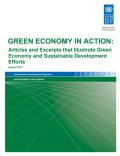
The Green Economy is one in which the vital linkages among the economy, society, and environment are taken into account. This selection of articles and excerpts emerged in response to the need to fill the knowledge gap on practical, concrete, and on the ground green economy country experience. It is in this spirit that the articles and excerpts included in this publication have been selected: to provide information and knowledge for policy and decision makers and practitioners on the positive implications of greening some priority sectors, including job creation, resource efficiency, and generally contribution to sustainable development through an extensive review of scientific publications and magazines.
The sectors analysed are water, agriculture, energy, industry, business, ecosystems, technology, waste management. The report contains several case studies, including from China, Egypt, the United Arab Emirates, the United Kingdom and Europe.
This report reviews the economic and environmental consequences of resource inefficiency in Asia and the Pacific and some of its underlying causes. It examines a range of technical, policy, and institutional responses to encourage corporations and consumers alike to adopt more resource-efficient behaviors, with particular attention to the vital role governments must play in creating incentive structures, encouraging research and development for new technologies, improving institutions and information exchange, and other measures to move the region’s economies toward greater resource efficiency. This analysis is a contribution to the global G8 3R Initiative, which seeks to promote the “reduce, reuse, recycle” approach to waste management. While many of the specific strategies described are not new, the report should contribute to an understanding of the underlying reasons behind resource inefficiency, tools for its analysis, and specific interventions tailored to the Asia and Pacific context.
The report includes case studies from China, India, Japan, Lao, Nepal, Philippines and Thailand.
This document is a review of the low carbon growth studies conducted in six emerging economies: Brazil, China, India, Indonesia, Mexico and South Africa. These countries, with the help of the Energy Sector Management Assistance Programme (ESMAP), have initiated country specific studies to assess development goals in conjunction with greenhouse gas mitigation opportunities. The aim is to present a framework for other countries who wish to implement studies of their own.
The paper is structured to mirror the seven step process of establishing a low carbon growth country study.
This paper highlights the implications of the current separation of the discourses on private climate finance (PCF) and on subsidies, and the opportunities that exist to unlock climate-compatible investment by linking these fields.
Though climate finance aims to enable climate compatible development (CCD), this paper points out that, within developing countries, subsidies to fossil fuels (alone) currently dwarf any efforts toward CCD through climate finance.
This publication, by UNEP, aims to identify the challenges faced in attempting to decouple human well‐being from resource consumption and exists as the first report amongst many investigations into decoupling which will be undertaken by the International Resource Panel and UNEP over the next few years. The report offers facts and statistics of natural resource flows and trade globally and notes that consumption of natural resources is still rapidly rising. A series of country wide case studies (Germany, South Africa, China and Japan) are presented that examine the decoupling potential of the countries in question. The report observes that developed countries appear to show stabilisation of resource and energy consumption however these economies appear to have exported the more energy and resource intensive elements elsewhere. There appears to be some success of relative decoupling (where resource intensity per unit growth falls) in developing countries but resource consumption in these economies is ‘steeply on the rise’.
